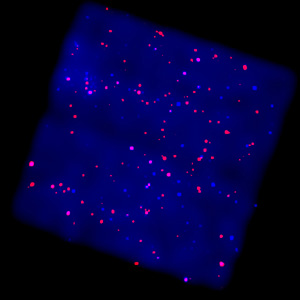Imagine the Universe News - 10 August 2001
Astronomers Go Behind the Milky Way to Solve X-ray Mystery
| 10 August 2001 |
Astronomers using the Chandra X-ray Observatory have peered behind the Milky Way galaxy for the first time, through layers of dust and gas that stretch out for 30,000 light years. They discovered 36 bright, distant galaxies lurking back there, and they found that the source of the Milky Way's X-ray emission is hot, diffuse gas.

|
|
Chandra's image of the "zone of avoidance." The diffuse blue emission is due to hot (ten million degree Celsius)
gas concentrated along the plane of the Galaxy. Most of the pink and
red objects in this image are believed to be to be active stars in our
Milky Way galaxy. The blue objects are considered to be distant
galaxies because of their x-ray properties. (Credit: NASA/GSFC/Ebisawa et al.) |
The findings, published in the online version of Science on August 10, settle a long-standing mystery about the source of the X-ray emission from the galactic plane and have broad implications for theories of how our galaxy has evolved.
Since the discovery in the mid-1970s of X-ray radiation in the Milky Way's galactic plane with the Uhuru satellite, scientists have debated whether this ubiquitous emission is diffuse light or from individual stars. Armed with Chandra, an international team led Dr. Ken Ebisawa of NASA Goddard Space Flight Center zoomed in on a tiny region of the galactic plane to investigate.
"The point sources we saw in the galactic plane were actually active galaxies with bright cores millions of light years behind our galaxy," said Ebisawa. "The number of these sources is consistent with the expected number of extragalactic sources in the background sky. We saw few additional point sources within our Galaxy." Because Ebisawa and his colleagues were able to identify these objects as being well beyond the galactic plane, they were able to determine that the X-ray glow from the galactic plane comes not from individual sources, but from the hot diffuse gas.
Light from the 36 newly discovered galaxies passes through our own Galaxy on its journey towards Earth. As the X-ray light passes through the Milky Way, it is affected by all that it passes through, thereby allowing astronomers to measure the distribution and physical condition of matter in our Galaxy. Detection of diffuse X-rays emanating from the Galactic plane indicates the presence of extremely hot, previously unknown, plasma gas. This gas is 100 times more energetic than any known existing gas in the interstellar medium, Ebisawa said.
Gas this hot would escape the gravitational confines of the Milky Way galaxy under normal circumstances. The fact that it still lingers within the Galactic plane is the next mystery to solve. Ebisawa suggests that magnetic fields may act to confine the heat and gas. Theorists, however, will wrestle with the Chandra observation's implications in months to come.
Some astronomers have proposed that white dwarfs -- stars like our Sun that have collapsed -- could have contributed to the Galactic plane X-ray emission. The Chandra observation rules out this possibility and implies there are fewer white dwarfs in our galaxy than previously thought.
The Chandra observation, conducted in February 2000, lasted 28 hours. The team observed what was known to be a "blank" region of the galactic plane in the constellation Scutum where an earlier Japanese X-ray satellite called ASCA found no individual X-ray sources.
The observation marks the first time astronomers have penetrated the heart of the so-called "zone of avoidance" -- a region of space behind which no observation has ever been taken. Thick dust and gas in the spiral arms of the Milky Way galaxy block out most forms of radiation. Thus, from our vantage point on the outer edge of the galaxy, we cannot see anything beyond the other side of our galaxy. X rays, however, can penetrate this dust and gas. Chandra, and now the European XMM-Newton satellite, are at long last beginning to collect light from behind our galaxy.
Participating in the Chandra observation and Science article are Yoshitomo Maeda of Pennsylvania State University; Hidehiro Kaneda of the Institute of Space and Astronautical Science in Japan; and Shogeo Yamauchi of Iwate University in Japan. Ebisawa joins NASA Goddard through the University Space Research Association.

